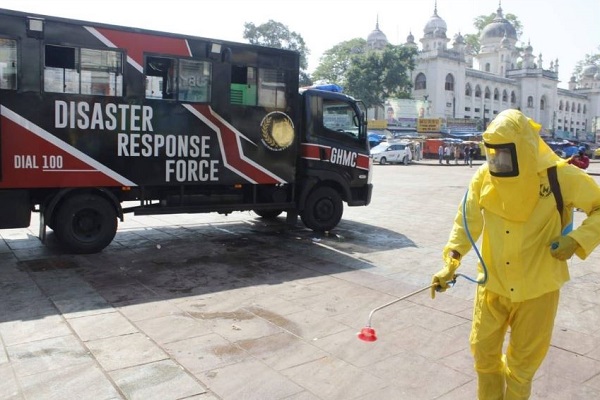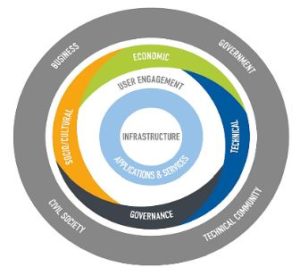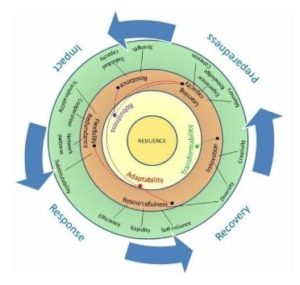
 The COVID-19 pandemic has overturned our lives. As it spreads over the globe, it is keeping us contained in our homes and reshaping our bonding with urban communities or cities. It has infected more than 33,83,439 globally (India -25,148) and killed more than 2,38,585 people worldwide and 1,152 in India as of May 02, 2020. The International Monetary Fund (IMF) has cut India’s growth estimate for FY21 to 1.9 percent from 5.8 percent estimated in January 2020. The pandemic has fortified the connections between public health, environment, and economy. The world is adapting to what will be the “new normal,” post COVID-19. The nature of the crisis calls for a policy and investment response to build a resilient city.
The COVID-19 pandemic has overturned our lives. As it spreads over the globe, it is keeping us contained in our homes and reshaping our bonding with urban communities or cities. It has infected more than 33,83,439 globally (India -25,148) and killed more than 2,38,585 people worldwide and 1,152 in India as of May 02, 2020. The International Monetary Fund (IMF) has cut India’s growth estimate for FY21 to 1.9 percent from 5.8 percent estimated in January 2020. The pandemic has fortified the connections between public health, environment, and economy. The world is adapting to what will be the “new normal,” post COVID-19. The nature of the crisis calls for a policy and investment response to build a resilient city.
Understanding a Resilient City
Resilience is what helps cities adapt and transform in the face of various challenges including the current situation and helping them to prepare for both the expected and the unexpected. 100 Resilient Cities defines urban resilience as “the capacity of individuals, communities, institutions, businesses, and systems within a city to survive, adapt, and grow no matter what kinds of chronic stresses and acute shocks they experience.”

Present situation – need of hour
The country is facing a systemic challenge which existed even before the COVID-19. This current impact was exacerbated by poor infrastructure, poverty, unemployment, environmental degradation, poor governance and leadership, and other chronic challenges. The aggravating weight of these unaddressed challenges has undermined the city’s resilience and, when coronavirus hit the nation, it exposed and worsened these weaknesses—ultimately making it more difficult for the nation to address these problems. COVID-19 has impacted interconnected systems, where recovery will have vast implications for future economic, social, and governmental activity.

Hence, resilience must become a core principle within the system management and operation to ensure we are able to continue to function despite disruptions like COVID-19 and are able not only to adapt and improve in its repercussions but to take advantage of new or revealed opportunities. Hence, there is a serious need of the future to transform the cities to be more resilient by adopting these following dimensions:
-
Public healthcare utilities & wellbeing
 Minimising underlying human vulnerabilities enable individuals and households to achieve a standard of living which goes beyond mere survival. One of the most cost-effective strategies for building resilience for people, especially in resource-constrained settings, is investing in core public health infrastructure for vulnerable groups through a basic provision of food, shelter including water and sanitation systems. Innovative and low-cost water, sanitation & hygiene (WASH) services and waste management practices serve as prevention to human transmission and also ensure the wellbeing of the communities livelihood.
Minimising underlying human vulnerabilities enable individuals and households to achieve a standard of living which goes beyond mere survival. One of the most cost-effective strategies for building resilience for people, especially in resource-constrained settings, is investing in core public health infrastructure for vulnerable groups through a basic provision of food, shelter including water and sanitation systems. Innovative and low-cost water, sanitation & hygiene (WASH) services and waste management practices serve as prevention to human transmission and also ensure the wellbeing of the communities livelihood.
Recommendations
-
Upgrade healthcare facilities (hospitals, medical equipment, dispensaries, telemedicine, medical tourism, health insurance and medical equipment) and designate hospitals.
-
Regulate and promote local production of supplies with quality controls. Hand sanitizers, surface disinfectants, can be produced by alcoholic beverage companies, laboratories, and community hospitals and pharmacies. PPEs can be produced by textile and plastic producing companies. This will also create more job opportunities for local people.
-
Regularly monitoring the environmental cleanliness on (cleaning floors, surfaces and any touchpoints at public places).
-
Training & skill development of waste handlers and sanitation workers on donning/doffing PPEs, decontamination, Infection Prevention and Control measures.
-
Assess and mitigate potential physical access barriers for vulnerable groups of people (senior citizens, health frontline workers, children, labourers).
-
Infrastructure & Environment
 There are clear links between infrastructure, health and the environment. Increase in air pollution, loss of biodiversity, urban heat islands, changing land-use patterns of cities has led to Climate Change. The world is certainly a quieter place in these days of the lockdown due to the COVID-19 pandemic. Newspapers report that the air is so clean that the snow-capped Himalayas are visible from Jalandhar, hundreds of kilometres away — something not seen in decades. Environment and infrastructure both provide critical services to urban populations. Reliable communications and mobility create daily connectivity between places, people and services. Smart public transport services allow safe and affordable travel. Post-COVID-19, economic activities are expected to resume albeit slowly. Public transport will need reliable support to provide a high quality of service and revive confidence from riders who may have fears about sharing public space with others.
There are clear links between infrastructure, health and the environment. Increase in air pollution, loss of biodiversity, urban heat islands, changing land-use patterns of cities has led to Climate Change. The world is certainly a quieter place in these days of the lockdown due to the COVID-19 pandemic. Newspapers report that the air is so clean that the snow-capped Himalayas are visible from Jalandhar, hundreds of kilometres away — something not seen in decades. Environment and infrastructure both provide critical services to urban populations. Reliable communications and mobility create daily connectivity between places, people and services. Smart public transport services allow safe and affordable travel. Post-COVID-19, economic activities are expected to resume albeit slowly. Public transport will need reliable support to provide a high quality of service and revive confidence from riders who may have fears about sharing public space with others.
Recommendations
-
Governments shall invest more in providing reliable and high-quality public transport. This will maintain and create new jobs for workers and also will reduce carbon emissions.
-
Strengthening policies that encourage more circular and efficient use of materials could improve global economic activity and reduce waste and pollution.
-
The government shall treat this lockdown due to COVID-19 as an opportunity to revive policies related to climate change, which will help in controlling pollution once the lockdown is over.
-
Strong policy-level interventions, guidelines by the Central Pollution Control Board (CPCB) and State Pollution Control Boards (PCB) must be implemented.
-
Protect hotspot zones to restrict traffic and public flow. Upgrade crucial infrastructures like airports, bus stands, railway stations with facilities like temperature scanners, law & order maintenance, emergency support using Integrated Command and Control Centres (ICCC) etc.
-
Put resources in designing quality spaces for pedestrians. These modes are not only resilient; they are affordable, they promote healthy lifestyles, and are integral to people’s access to public transport.
-
Urban land use management processes such as land-use planning, development controls, Greenfield development, and urban redevelopment provide opportunities to make a resilient city
-
Society & Economy
 The existence of an economy is essential to the formation and maintenance of society. No society can survive without an economy efficient enough to meet, at the very least, the basic needs of its members. Also, a strong integrated economic system is required to sustain the investment that a nation needs to maintain its infrastructure and provide for its communities. It helps to create contingency funds, which can be used in a crucial time. Also, resilient city optimises revenues and expenditures, and leverage funds from non-government, SHG groups, civic societies, and business sources where appropriate through public –private partnership (PPP) or any grant funding.
The existence of an economy is essential to the formation and maintenance of society. No society can survive without an economy efficient enough to meet, at the very least, the basic needs of its members. Also, a strong integrated economic system is required to sustain the investment that a nation needs to maintain its infrastructure and provide for its communities. It helps to create contingency funds, which can be used in a crucial time. Also, resilient city optimises revenues and expenditures, and leverage funds from non-government, SHG groups, civic societies, and business sources where appropriate through public –private partnership (PPP) or any grant funding.
Recommendations
-
More numbers of SHGs, civic societies, community institutions to raise awareness and give training to people in any calamity. This could help to enable the socio-economic transformation in a positive manner.
-
Encouragement towards Corporate Social Responsibility (CSR) initiatives to increase funds/grants for community development.
-
Development and strengthening of rural infrastructure and housing, creation of employment opportunities in rural areas and facilitation and diversification of rural livelihoods. This is suggested, because of this COVID-19 lockdown against the backdrop of a major migration of people from urban to rural areas, who returned to their native places.
-
A detailed survey of skilled and non-skilled migrant workers to allocate local opportunities to work under various schemes.
-
More allocations of funds/budgets for schemes like Mahatma Gandhi Rural Employment Guarantee Scheme (MGNREGS), Pradhan Mantri Awaas Yojana Gramin (PMAY-G), Pradhan Mantri Gram Sadak Yojana (PMGSY) and National Rural Livelihood Mission (NRLM), “Swarna Jayanti Grama Swarojgar Yojana” (SGSY) and Pradhan Mantri Kaushal Vikas Yojana (PMKVY).
-
Governance & Leadership
 Resilience is also about governance & capacity building. It is important to facilitate the engagement of local government decision-makers, academic institution, private sector and the community within the local government. City leaders are expected to develop enabling environments to facilitate effective partnerships so that all can positively contribute towards risk reduction; partnership is essential to build resilience.
Resilience is also about governance & capacity building. It is important to facilitate the engagement of local government decision-makers, academic institution, private sector and the community within the local government. City leaders are expected to develop enabling environments to facilitate effective partnerships so that all can positively contribute towards risk reduction; partnership is essential to build resilience.
Recommendations
-
The government will serve as an umbrella for activities that need to happen post-COVID-19. Ensure clarity in roles, relationships and coordination mechanisms in the health system and across government.
-
Promote campaign activities/awareness programs to build resilience especially for a vulnerable group. Teach people in advance how to respond and follow up with any calamity. Training agencies include the health department, IT department, the police department, the fire department, and national weather service.
-
Revive healthcare infrastructure and governance structure communities, Urban Local Bodies(ULBs) and local self-government (Panchayats) especially in the rural sector.
-
Government bodies must prepare strict guideline/actions towards land use regulations, environmental protection measures, existing norms and response plans to strengthen planned and resilient development.
-
Set emergency shelters (such as Gurudwaras, Temples, and churches) and sources of food/water (such as grocery stores). Develop Memorandums of Understanding (MoUs) with these places. These places should maintain supplies (e.g. food, water, clothing, medicines) so that they are prepared for an emergency.
-
Smart Technology Innovation
 The most important step for cities to leverage the full capabilities of technology to support urban resilience will be to build a culture that supports innovation and the adoption of new technologies and the change these technologies will drive. The COVID-19 pandemic has brought a new sense of urgency to innovative efforts. Cities have to opt for massive digital infrastructure that would support a shift to the modern methods of a digitised world. People will see smart technology playing an enhanced role that will shape and reshape businesses conduct and consumer behaviour can help support future response and resilience mechanisms.
The most important step for cities to leverage the full capabilities of technology to support urban resilience will be to build a culture that supports innovation and the adoption of new technologies and the change these technologies will drive. The COVID-19 pandemic has brought a new sense of urgency to innovative efforts. Cities have to opt for massive digital infrastructure that would support a shift to the modern methods of a digitised world. People will see smart technology playing an enhanced role that will shape and reshape businesses conduct and consumer behaviour can help support future response and resilience mechanisms.
Recommendations
-
Put resources into Information and Communication Technologies (ICT) related infrastructure which helps in the prevention, mitigation and management of any calamity. Enable Public Distribution System (PDS) with ICT facilities for fairly distribution of food, medicines and other necessary items.
-
Upgrade and provide more research and development centres, Virology Institutes to accelerate diagnostics, vaccines and therapeutics.
-
Develop similar digital solutions like Aarogya Setu, TraceCOVID, and SAMPRAC.
-
Encourage a web-based information platform, where cities and local governments can share their own tools, plans, regulations.
-
Strong emphasis on establishing communication lines that can be relied upon during a disaster, especially for the vulnerable community.
Conclusion
It is pretty obvious that challenge posed by the spread of COVID-19 pandemic is very serious, but this challenge must be perceived as an opportunity by the government/ULBs/agencies as well as the individuals to develop and reshape our economy, make cities more resilient. Urban Planners can act as a catalyst in the implementation of integrated strategies or policies (Public health, WASH, Environment, and Economy) and ensure that different projects and programmes across a city are aligned, mutually beneficial, reflective of past experience and resourceful in any calamity.
Author – Amanpreet Kaur is an Uran Expert and holds a Master’s degree in Environment Planning from School of Planning and Architecture (SPA) Vijayawada. She has rich working experience in Government and Infrastructure Advisory, Urban & Environment Planning, Transportation Planning, Public Sector Reforms, Institutional Strengthening, and Organizational Development & Capacity Building.
Be a part of Elets Collaborative Initiatives. Join Us for Upcoming Events and explore business opportunities. Like us on Facebook , connect with us on LinkedIn and follow us on Twitter, Instagram.











